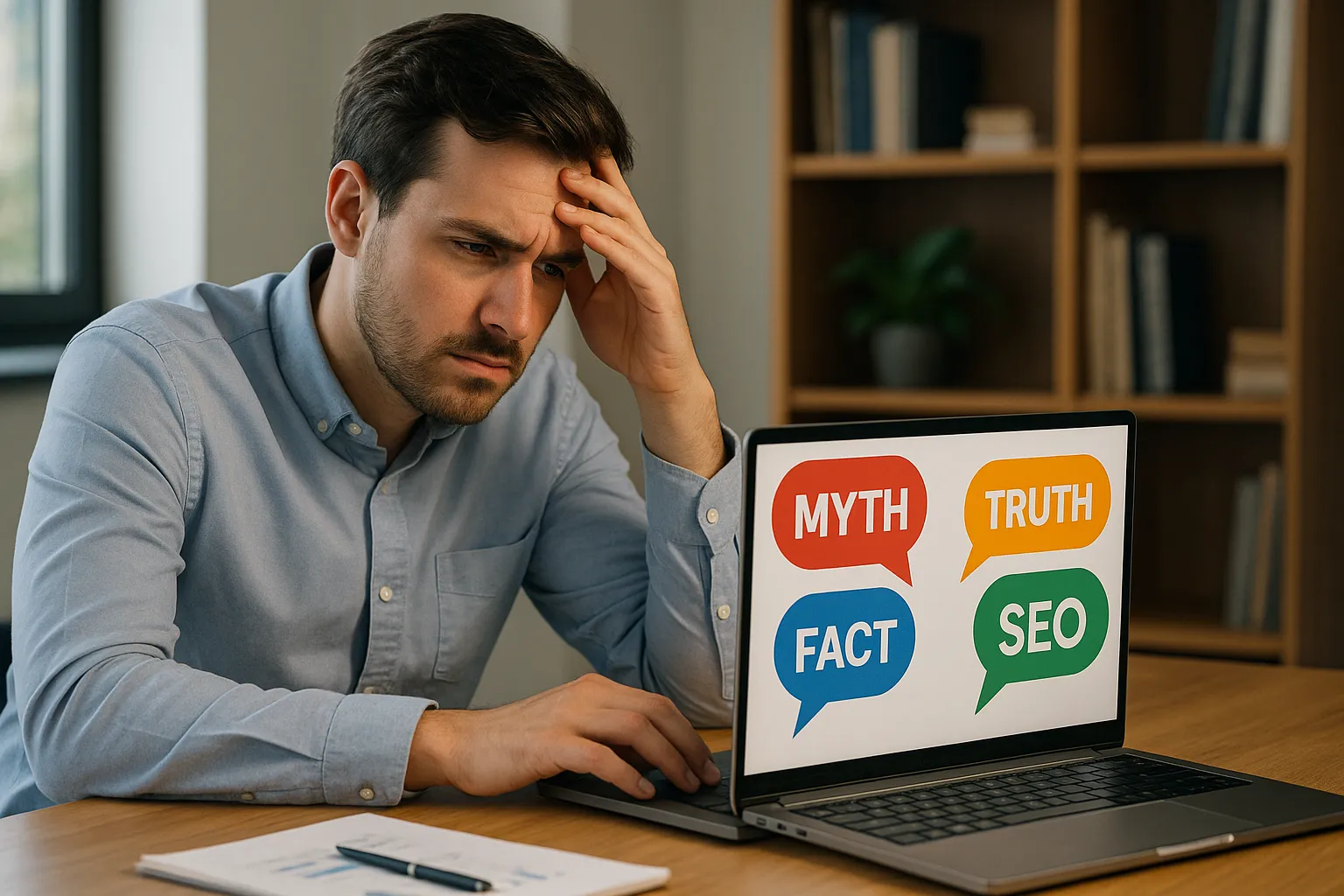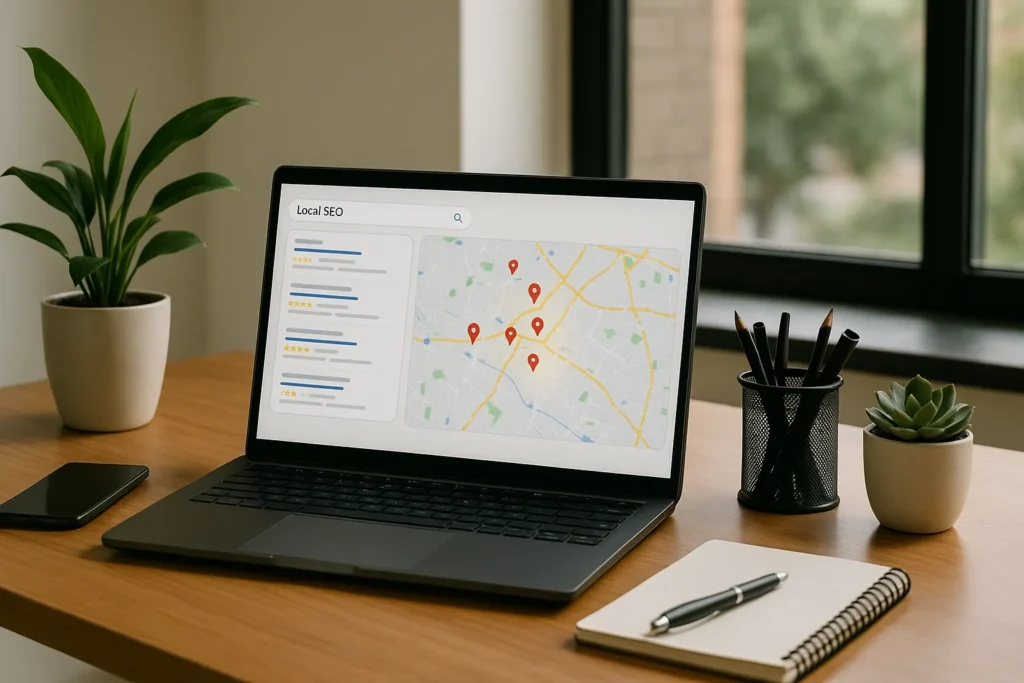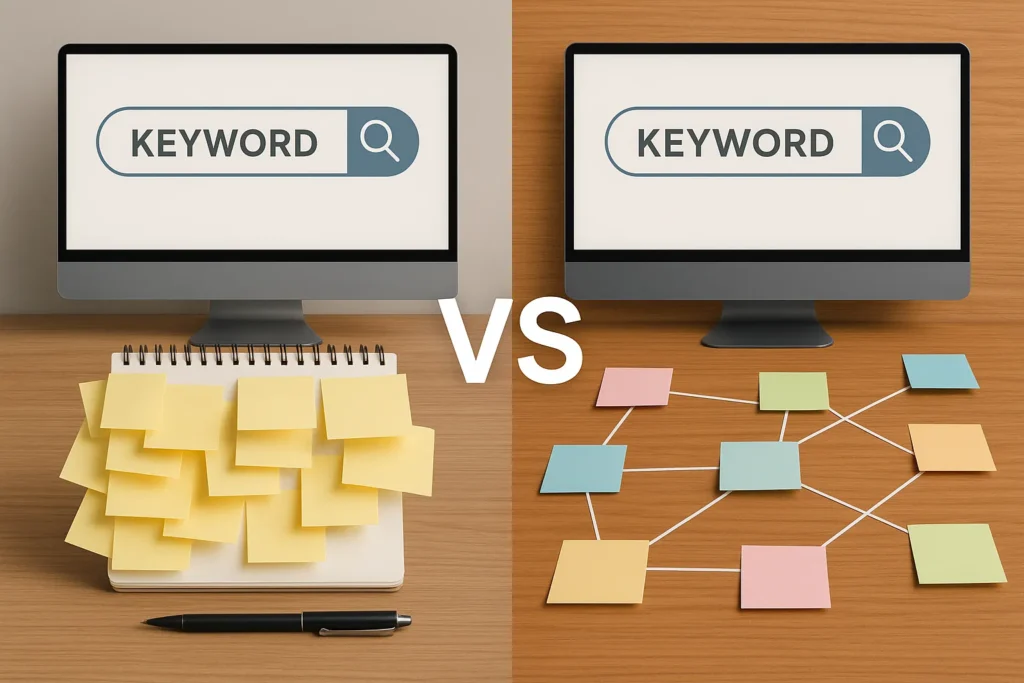
SEO Myths Holding Your Business Back (And What to Do Instead)
If you’re frustrated from watching competitors rank higher while your business website stays buried, you’re dealing with outdated search engine optimization (SEO) advice. The problem stems from business owners who fall for the same SEO myths from years ago.
In this guide, we’ll expose the truth behind common SEO myths in 2025 and show you what works today.
We’ll cover in this blog:
- Why “SEO is dead” costs businesses real money
- Expecting overnight rankings sets you up for failure
- How keyword strategies have evolved
- Quality beats quantity in modern link building
- What Google’s algorithm prioritizes now
Read on to get the full story about which local SEO ranking factors really work for your business.
Local SEO Ranking Factors That Work

Most business owners believe SEO is dead because they don’t see results immediately. But people still turn to Google first when they need local services like plumbers, restaurants, or dentists.
Here’s what really drives local SEO success in 2025:
Google My Business Still Rules Local Search
Your business profile affects how you show up when people search for services near them. That’s why complete profiles with photos, active hours, and contact info get significantly more clicks than incomplete ones.
Reviews and Ratings Impact Your Rankings
Google uses customer feedback as a major ranking signal for local businesses. In fact, studies show that 57% of consumers won’t even consider a business with fewer than 4 stars. This percentage basically indicates that Google prioritizes highly-rated businesses to match what searchers want to find.
Location-Based Content Brings Local Traffic
Write about your city or neighborhood to attract nearby customers who search for local services. A strategy like this works because local blog posts can double your visibility for “near me” searches.
The truth is that local SEO is effective when you focus on what Google values. These ranking factors determine whether potential customers find your business first. That’s why, we recommend focusing on these proven factors instead of chasing common SEO myths that waste your time.
Why Immediate Results Don’t Happen (And What Does)
Business owners want immediate results from SEO, but search engines don’t work that way. Because overnight SEO rankings are like planting a seed and demanding fruit the next morning.
For instance, with SEO timelines, Google takes time to evaluate your site before improving your search position. In fact, most websites see ranking improvements after 3 to 4 months of consistent SEO work. The long time duration is because search engines need data about how users respond to your content.
During the SEO waiting period, your website traffic grows gradually as Google gains confidence in your pages. At the same time, search algorithms monitor your bounce rate and engagement, which inform Google if your content outperforms competitors.
Since search engines prioritize sustained engagement over quick wins, SEO success works like training for a marathon instead of sprinting 100 yards. So, your SEO rankings improve when you build authority through regular content updates and technical optimizations.
Now that we’ve covered realistic timelines, let’s discuss how your keyword approach might be sabotaging your progress.
Keyword Stuffing vs More Keywords That Help

Keyword stuffing remains one of the most damaging SEO myths of 2025. Unfortunately, business owners still overpack keywords into their content, thinking Google will reward them with higher rankings.
The reality shows that a different approach wins the ranking factor game:
What Doesn’t Work:
- Outdated tactic: Jam your target keyword into every paragraph and heading. The problem is, this keyword stuffing approach creates content that sounds robotic and immediately drives visitors away from your site.
- Old-school mistake: If you stuff meta tags with repetitive keyword phrases, Google ignores your page descriptions entirely. Instead, search engines prefer titles and descriptions that clearly explain what visitors will find.
- Dangerous habit: Multiple pages targeting identical keywords create duplicate content issues that hurt your entire website. Even worse, Google penalizes sites that appear to manipulate search results through repetitive content strategies.
What Gets The Job Done:
- Winning approach: Many successful websites use their main keyword naturally just 2-3 times per page. Plus, Google’s algorithm now recognizes semantic variations and related terms that provide better user experiences.
- Proven alternative: Google rewards meta tags that focus on user intent rather than keyword density. As a result, well-written descriptions increase click-through rates and help your pages rank higher in search results.
- Better option: Comprehensive pages covering related topics naturally attract more keywords and higher rankings. In fact, this single-page approach builds topical authority while avoiding duplicate content penalties that damage your SEO performance.
Based on our experience, more keywords work when you focus on search intent. At the same time, Google’s algorithm rewards pages that provide value over those that manipulate rankings.
Meanwhile, duplicate content penalties hit websites that prioritize keyword density over user experience.
Domain Authority and Authoritative Websites Explained

Now that we’ve covered effective keyword strategies, let’s expose another costly myth about link building.
Many business owners believe more links automatically mean better search rankings. The reality is that domain authority beats link quantity when Google evaluates your website.
Google measures website authority through several quality signals:
- Consistent Publishing: Years of publishing quality content build real domain authority over time. For example, major sites like Mayo Clinic earn high authority scores because they consistently provide expert information. As a result, other authoritative websites naturally reference and trust their medical content.
- Industry Relevance: A dentist benefits much more from one dental association mention than from dozens of unrelated directory links. It’s because Google recognizes when links come from relevant, trusted sources in your field rather than random websites.
- Natural Citations: Google rewards websites when authoritative sources link to their content without being asked. For example, when Harvard Medical School references your health article, this link signals genuine quality to search engines and boosts your rankings significantly.
Quality backlinks take months or even years to earn naturally. However, one authoritative website linking to your content can boost your search results more than hundreds of low-quality directory links.
Even the best links can’t fix fundamental website technical issues like meta tags and bounce rates, which we’ll cover next.
Meta Tags and Bounce Rate: The Direct Impact on Rankings
Most business owners focus on getting traffic but ignore what happens when visitors arrive. However, meta tags and bounce rates create a direct impact on how your SEO performs overall.
Think of these tags like a movie trailer for each page on your website. Good meta descriptions convince people to click your link instead of competitors. When you optimize these meta elements, Google’s algorithm notices the engagement and improves your SEO rankings.
Your bounce rate shows if visitors find value on your pages and stay engaged. In fact, Google’s algorithm tracks how long people stay and what they do next. As a result, websites that keep visitors engaged naturally climb higher in search results than competitors.
To stay relevant with SEO, you need regular audits of your website’s performance. The truth is that sites that continuously optimize their user experience outrank competitors who handle SEO once and then ignore it completely.
Let’s wrap up with actionable strategies that turn these insights into measurable growth for your business.
SEO Strategies That Drive Results in 2025
We’ve exposed the biggest SEO myths that cost businesses money and effort. Fortunately, you now know the truth about modern SEO.
The reality is that SEO strategies that drive results focus on creating genuine value for your potential customers instead of trying to trick search engines. Plus, the direct impact of proper SEO takes months to show, but the results compound over time when you build trust with both Google and real visitors.
Instead of chasing SEO myths, your business deserves SEO that works based on facts.
At Studio Paralelo, we help businesses create optimized websites and quality content that ranks higher in search results. Our team understands what Google really wants and builds SEO strategies that deliver lasting growth.
Get in touch today to discuss how we can help you reach your goals with proven SEO techniques.